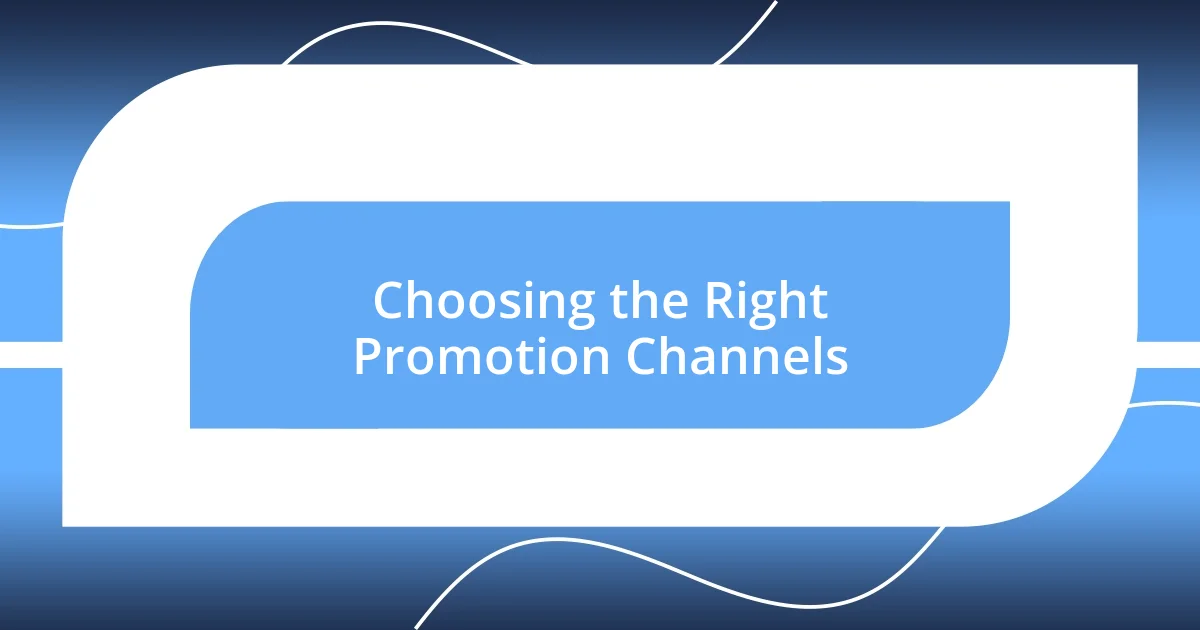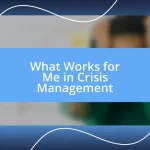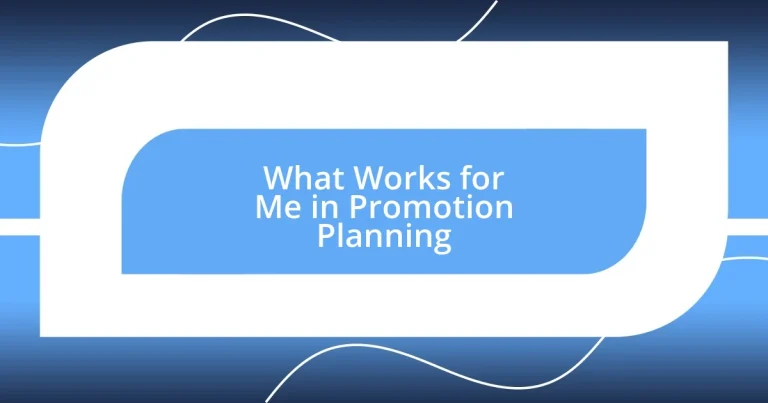Key takeaways:
- Effective promotion planning is essential for aligning business goals and fostering team collaboration, leading to successful campaigns.
- Setting specific, measurable goals enhances focus, ensuring that promotional efforts are directed and impactful.
- Continuous tracking, analysis of customer feedback, and adaptability are crucial for refining promotional strategies and learning from past experiences.

Understanding Promotion Planning Importance
Understanding the importance of promotion planning is crucial for any business aiming for growth. In my experience, a well-structured plan can mean the difference between a campaign that flops and one that soars. Have you ever felt that excitement when your carefully thought-out strategy starts to pay off? It’s incredibly rewarding.
I recall a time when I unintentionally skipped the planning phase in a rush to launch a new product. The result? A lackluster turnout that still haunts me. It taught me that promotion planning not only serves as a roadmap but is also essential for aligning your goals with effective tactics. How can you measure success without a clear plan in place?
Moreover, promotion planning isn’t just about setting targets; it creates a sense of purpose within the team. When everyone understands their role and the overall vision, it fosters collaboration and motivation. I’ve witnessed firsthand how a shared focus can ignite creativity and drive results. Isn’t it inspiring to see a group rally together around a shared goal?

Setting Clear Promotion Goals
Setting clear promotion goals is like having a compass in an uncharted territory. From my perspective, I’ve learned that vague ambitions lead to scattered efforts, which ultimately dilute the impact of any campaign. When I set precise, measurable goals, it’s as though I can almost feel the focus sharpening across my team—everyone suddenly knows what success looks like.
Here are some key points I consider when defining my promotion goals:
- Be Specific: Clearly define what you want to achieve, whether it’s increasing brand awareness or boosting sales.
- Make It Measurable: Use metrics like sales numbers or engagement rates to track progress and outcomes.
- Ensure Achievability: Set realistic targets that challenge you but are still attainable based on your resources.
- Relevance Matters: Align your goals with broader business objectives to maintain clarity and purpose.
- Timely Deadlines: Establish a timeframe for achieving your goals to create urgency and keep the team motivated.
Reflecting on a past campaign, I remember how we aimed to improve customer engagement. Initially, we set a general goal of “increasing interactions,” but it wasn’t until we refined it to a 25% uplift in social media engagement over three months that we could rally the team effectively. The focus we gained made all the difference, turning our strategy into a dynamic journey filled with enthusiasm and collaboration.

Identifying Target Audience Effectively
Identifying your target audience effectively is pivotal in shaping any promotional strategy. It’s astonishing how clarity in understanding who you’re trying to reach can transform your approach. I remember the first time I conducted a thorough audience analysis; I was amazed at the depth of insight it provided. Suddenly, my campaigns weren’t just shots in the dark, but tailored messages that resonated deeply with potential customers.
To effectively identify your target audience, it’s crucial to gather demographic information and understand psychographics. This includes age, gender, location, interests, and behaviors. What really struck me was the impact of combining this information with customer feedback. Once, after launching a targeted campaign based on solid data, the response was overwhelming. The thrill of seeing engagement skyrocket because we truly spoke the language of our audience was indescribable. Have you ever thought about how much richer your marketing messages could be if they were crafted with your audience in mind?
Finally, leveraging social media analytics has become an invaluable tool for fine-tuning audience identification. These platforms provide a wealth of data regarding who is engaging with your content. A memorable moment for me was when I analyzed our audience insights after a campaign. I realized we had attracted a demographic we hadn’t even considered initially. This realization prompted a shift in our messaging, allowing us to cater specifically to those users. Engaging with your audience’s evolving needs is essential; it’s a journey worth taking. How often do you check in on the changing preferences of your audience?
| Demographics | Psychographics |
|---|---|
| Age | Interests |
| Gender | Values |
| Location | Lifestyle |
| Income Level | Buying Behavior |

Choosing the Right Promotion Channels
Choosing the right promotion channels can make or break your campaign. I vividly recall a time when we relied heavily on traditional media, only to find our engagement plummeting. It was a wake-up call—shifting focus to digital channels not only revitalized our outreach but also connected us to our audience in real-time. Have you ever felt the sheer excitement of seeing immediate responses to your content online?
It’s essential to evaluate which channels resonate best with your target audience. For instance, when I began focusing on social media platforms like Instagram, the increase in visual storytelling encouraged our team to think creatively. Turning our product features into engaging stories transformed our promotional approach, making it feel more like a conversation. Don’t you think your audience would appreciate a more personal connection through the platforms they frequent?
Experimentation is key in this process. I remember testing different channels during a product launch, and surprisingly, TikTok garnered the most attention. The engagement we received was thrilling, pushing us to adapt our strategies on the fly. Recognizing that each channel has unique strengths gives us the freedom to tailor our messaging. Isn’t it amazing how a single platform can redefine your promotional landscape, leading you to explore new territories in reach and engagement?

Creating an Engaging Promotion Message
Creating an engaging promotion message requires more than just catchy slogans; it’s about forging a connection with your audience. I once crafted a message that focused on a personal story related to our product, which transformed mundane details into an emotional narrative. The feedback was incredible! Customers didn’t just hear our message—they felt it. Have you ever noticed how a heartfelt story can linger in your mind far longer than just a sales pitch?
I believe that incorporating a sense of urgency can be a powerful motivator too. During a recent promotion, I integrated limited-time offers into our messaging, which sparked immediate interest. Suddenly, our audience felt compelled to act rather than delay. It was a thrilling rush to see a flurry of purchases come in as people rushed to take advantage of the opportunity. Isn’t it fascinating how time constraints can elevate engagement and drive action?
A well-crafted promotion message also speaks directly to the emotions of the audience, highlighting benefits that resonate with their desires and needs. I remember creating a campaign that focused on the idea of comfort during a challenging time, and the response was overwhelming. People shared their own stories and experiences, reinforcing that our message sparked a communal bond. How often do you consider the emotional aspect while crafting your messages? Engaging emotionally can truly turn a simple promotion into a shared journey with your audience.

Tracking and Measuring Promotion Success
Tracking the success of a promotion is more than just looking at numbers on a spreadsheet; it’s about understanding the story behind those figures. I recall a campaign where we didn’t just count sales but also analyzed customer feedback and engagement metrics across different platforms. This deep dive revealed patterns about what resonated with our audience, allowing us to tweak future promotions more effectively. How often do you pause to reflect on the “why” behind your campaign results?
One aspect I found invaluable was setting clear Key Performance Indicators (KPIs) prior to launching a promotion. For instance, during a holiday campaign, we decided on metrics like social shares and newsletter sign-ups alongside sales figures. As the promotion unfolded, we were able to assess not only immediate sales impact but also long-term audience growth, revealing insights about brand loyalty that hadn’t been evident before. Isn’t it rewarding to see connections forming with your audience, beyond just numbers?
It’s essential to keep an ongoing dialogue with your team about what the data highlights. On one occasion, my team and I noticed a dip in engagement three days into our launch. Instead of accepting it as a setback, we quickly convened to brainstorm new content strategies, which reignited interest in our promotion. That experience taught me that adaptability—and willingness to pivot—is crucial in response to real-time insights. How does your team handle unexpected challenges while tracking performance? Embracing nimbleness can turn potential failures into growth opportunities.

Adjusting Strategies for Future Promotions
Adjusting strategies for future promotions requires a keen awareness of past successes and failures. I remember a time when a particular social media campaign didn’t quite hit the mark. Instead of just moving on, my team gathered to dissect what went wrong. By identifying the specific elements—like timing and audience targeting—we were better prepared for the next round. It made me wonder: how often do we truly learn from our past efforts?
Listening to customer feedback has been a game-changer in refining my approach. After one promotional event, several customers expressed confusion about our messaging. Rather than dismissing it, I took their words to heart and shifted our focus on clarity. The next campaign was clearer and resonated more with our audience. It was rewarding to see engagement jump. Have you ever considered how customer insights can shape your promotional strategies?
Testing and iterating has also been crucial in my approach. During one promotion, we tried different ad formats, and I was surprised to find that videos performed significantly better than static images. This revelation prompted me to adopt a more experimental mindset moving forward. Isn’t it exciting how a willingness to test new ideas can not only enhance results but also invigorate your creativity? Embracing this trial-and-error approach has truly transformed the way I plan future promotions.












